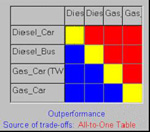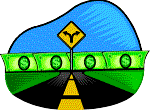CEEESA Decision Analysis Tools
The Center for Energy, Environmental, and Economic Systems Analysis (CEEESA) provides decision analysis tools that cover a wide range of issues. The table below summarizes the available models. Click on each model name to get more information.
| Multi-Criteria Trade-Off Analysis |
DAM |
| Decision Analysis |
IDEA |
| Portfolio Analysis |
PASS |
| Risk Allocation |
ARAM |
| Stochastic Technology Comparison |
STATS |
Decision Analysis Model (DAM)
 DAM was developed to aid decision analysts in solving multiple-criteria decision analysis problems. This Windows-based software (1) allows analysts to view a decision problem and find the best solution from different perspectives; (2) performs standard, but time-consuming, tasks quickly and efficiently; (3) offers a range of decision analysis and trade-off methods that cannot be performed manually; and (4) presents results in convenient graphical and numerical formats. DAM also allows for imprecise or interval trade-offs. DAM was developed to aid decision analysts in solving multiple-criteria decision analysis problems. This Windows-based software (1) allows analysts to view a decision problem and find the best solution from different perspectives; (2) performs standard, but time-consuming, tasks quickly and efficiently; (3) offers a range of decision analysis and trade-off methods that cannot be performed manually; and (4) presents results in convenient graphical and numerical formats. DAM also allows for imprecise or interval trade-offs.
For more information about the Decision Analysis Model (DAM), contact CEEESA.
Interactive Decision Analysis (IDEA)
IDEA is a PC-based software package used for a wide variety of decision problems. Features include easy data entry via customized forms, cues, and prompts for each input field, detection of invalid entries, on-line help, control of screen attributes, and graphical display of results. In addition, online “consultants” assist in quantifying probability distributions over uncertain variables, determining the strength of preferences for different amounts of an individual attribute, and determining the preferences for changing the amount of one attribute in comparison to changing the amount of another.
For more information about Interactive Decision Analysis (IDEA), contact CEEESA.
Portfolio Analysis Support System (PASS)
 PASS helps users effectively allocate limited resources — funds, personnel, and facilities — by better understanding the pros and cons of different proposals. An easy-to-use, computer-based decision support system for portfolio analysis, PASS helps define and analyze strategies for allocating limited budgets among competing projects or program areas. The model identifies alternatives that best achieve objectives and examines project sequencing and equity through the use of portfolio constraints. PASS provides many benefits, including defensible resource allocations, quick answers to “what if” questions, a focused decision-making process, insights into priorities, and enhanced communications. PASS helps users effectively allocate limited resources — funds, personnel, and facilities — by better understanding the pros and cons of different proposals. An easy-to-use, computer-based decision support system for portfolio analysis, PASS helps define and analyze strategies for allocating limited budgets among competing projects or program areas. The model identifies alternatives that best achieve objectives and examines project sequencing and equity through the use of portfolio constraints. PASS provides many benefits, including defensible resource allocations, quick answers to “what if” questions, a focused decision-making process, insights into priorities, and enhanced communications.
For more information about Portfolio Analysis Support System (PASS), contact CEEESA.
Argonne Risk Allocation Model (ARAM)
The ARAM system aids decision makers in negotiating the allocation of programmatic risks between two parties — the principal (who pays for services) and the agent (who performs services for payment). Users first describe the risks, such as technical performance, permitting, and force majeure, and then develop several alternatives for allocating each risk. For each risk and alternative allocation, users describe the mitigation and prevention measures that each party is likely to take. The model addresses risk dependence and financial market responses to uncertain outcomes. It uses Monte Carlo simulations to express cost results in probabilistic form.
For more information about Argonne Risk Allocation Model (ARAM), contact CEEESA.
Stochastic Analysis of Technology Systems (STATS)
Originally developed to estimate composite cost and performance uncertainty distributions for various systems and technologies, STATS provides a convenient approach for treating combinations of component uncertainties and potential correlations between cost and performance components. The approach has the capacity to improve comparisons based simply on combinations of best point estimates. The additional information developed in uncertainty analysis is useful when considering the relative risks and benefits of technology or system expansion options.
For more information about Stochastic Analysis of Technology Systems (STATS), contact CEEESA. |

 DAM was developed to aid decision analysts in solving multiple-criteria decision analysis problems. This Windows-based software (1) allows analysts to view a decision problem and find the best solution from different perspectives; (2) performs standard, but time-consuming, tasks quickly and efficiently; (3) offers a range of decision analysis and trade-off methods that cannot be performed manually; and (4) presents results in convenient graphical and numerical formats. DAM also allows for imprecise or interval trade-offs.
DAM was developed to aid decision analysts in solving multiple-criteria decision analysis problems. This Windows-based software (1) allows analysts to view a decision problem and find the best solution from different perspectives; (2) performs standard, but time-consuming, tasks quickly and efficiently; (3) offers a range of decision analysis and trade-off methods that cannot be performed manually; and (4) presents results in convenient graphical and numerical formats. DAM also allows for imprecise or interval trade-offs. PASS helps users effectively allocate limited resources — funds, personnel, and facilities — by better understanding the pros and cons of different proposals. An easy-to-use, computer-based decision support system for portfolio analysis, PASS helps define and analyze strategies for allocating limited budgets among competing projects or program areas. The model identifies alternatives that best achieve objectives and examines project sequencing and equity through the use of portfolio constraints. PASS provides many benefits, including defensible resource allocations, quick answers to “what if” questions, a focused decision-making process, insights into priorities, and enhanced communications.
PASS helps users effectively allocate limited resources — funds, personnel, and facilities — by better understanding the pros and cons of different proposals. An easy-to-use, computer-based decision support system for portfolio analysis, PASS helps define and analyze strategies for allocating limited budgets among competing projects or program areas. The model identifies alternatives that best achieve objectives and examines project sequencing and equity through the use of portfolio constraints. PASS provides many benefits, including defensible resource allocations, quick answers to “what if” questions, a focused decision-making process, insights into priorities, and enhanced communications.